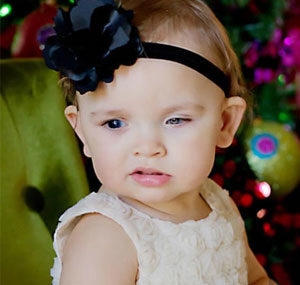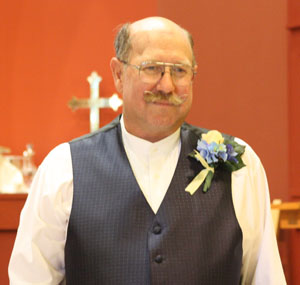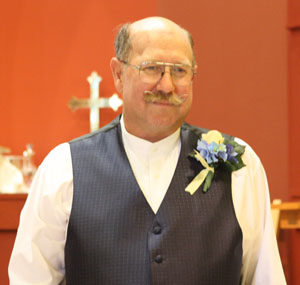
Nov 13, 2013 | Recipient Stories

Fred, from Springfield, Missouri, received a sight-saving corneal transplant in 1970, long before corneal transplant surgery became the outpatient procedure it is today. His story is a touching reminder of just how precious the gift of sight can be.
Fred, from Springfield, Missouri, received a corneal transplant in November of 1970 before corneal donation and transplantation were as well-established as they are now. Saving Sight (known then as the Missouri
Lions Eye Bank) and the Eye Bank Association of America were only 10 and 9 years old, respectively, and most organ procurement organizations did not yet exist. Instead, transplant surgeons sourced their corneal tissue through small, often hospital operated donor programs. Recipients frequently rejected the transplants within a few years, meaning they would usually have to go through an arduous surgery and recovery process multiple times to regain their sight.
Born with 20/400 eyesight in his left eye, Fred was legally blind in one eye (he likens it to putting Vaseline on the lenses of a pair of glasses). In fourth grade, Fred’s seeing right eye was poked with a stick, which later caused a growth to develop on his cornea, and his vision in that eye eventually progressed to blindness, too. The doctor he had been seeing referred him to a specialist in St. Louis. After Dr. Kolker, an ophthalmologist at Washington University, had exhausted all other treatments and Fred had been blind for two years of junior high, he recommended that the 14-year-old undergo a corneal transplant. Transplants only had a two-year expectancy at the time before the body would reject them, but Fred, Dr. Kolker, and his family decided that was better than the alternative.
Fred and his parents were put on call until several months later when the family of a 31-year-old in the St. Louis area who died in a car accident made the heroic choice to donate his corneas. “I was in school at a pep rally when Dr. Kolker called,” Fred remembered, “and Mom and Dad picked me up. We were in St. Louis that evening where I was admitted to McMillan Hospital. And the next morning they did the transplant bright and early.” Fred’s recovery was a six-month process, partly because of the fear of rejection and partly because he received two dozen hand-sewn stitches to replace his cornea. After the surgery, both of his eyes were bandaged to keep them immobile. “I could shower and use the restroom, but otherwise I had to stand straight up or lay on my back for two weeks,” he reported. Afterward, they took the bandage off his left eye, enabling him to see somewhat, but finally, months later, the bandage was removed from Fred’s right eye. “I remember taking the bandage off and having to wear sunglasses for a while,” Fred recalled. “I hadn’t seen the sun in a long time, so my eye was very sensitive.”
But Fred’s recovery was not complete. “Almost 2 years to the day after my transplant, my eye started getting red and watering,” he said. “So they hospitalized and isolated me. They used a drug to weaken my immune system and then built my body back up. I was in isolation for two weeks until my body accepted the cornea.” The intervention worked, though, and he hasn’t had any more problems, to this day.
The corneal transplant recipients that Saving Sight serves today have a very different experience. Thanks to generous eye donors and a strong eye banking infrastructure across the country, a surgery can be scheduled within a few weeks or months, depending on the surgeon’s schedule. And the operation is an outpatient procedure due to advances in surgical and processing techniques. The recipient must remain relatively immobile for a few days, but vision typically comes back within a couple of weeks.
Fred had to give up contact sports and playing the trumpet, the latter for fear that the pressure in his head would damage the transplant, but otherwise, he was able to make a full recovery and do the things he loves. He even got his driver’s license when he turned 16. But he still keeps a set of Braille playing cards he received during his time of blindness. “They remind me where I come from back in those days,” he said. Today, Fred is a member of several service organizations and supports donation in his community. “My wife and I have been on the donor list since 1980,” he said. “When you get your new license, you need to have that donor symbol on there.”
In the last 43 years since Fred’s transplant, Saving Sight and the transplant surgeons it partners with have made considerable advancements, the result of which is recipients regaining their sight quickly and with less pain. And more people than ever are saying yes to donation and joining the eye, organ, and tissue donor registry. To join the millions of Americans like Fred who have declared their choice to be donors, visit the Donate Life America website or a local Department of Motor Vehicles office.

Sep 25, 2013 | Recipient Stories

Cathy from Bethalto, Illinois suffers from keratoconus, but thanks s to a cornea transplant, her vision and her life have improved.
Cathy from Bethalto, Illinois didn’t know she was suffering from a serious eye disease until she sought a consultation for Lasik surgery. The surgeon explained that the reason her contacts no longer fit and why she wasn’t a candidate for Lasik was because the shape of her cornea was slowly changing due to keratoconus. According to the National Keratoconus Foundation, the disease “is a non-inflammatory eye condition in which the normally round dome shaped cornea progressively thins, causing a cone-like bulge to develop.” Keratoconus significantly impairs vision for about 1 in every 2,000 people, but its cause remains unknown. Cathy began using rigid, gas permeable contact lenses that helped give her eyes a smooth, rounded shape, resulting in better vision. But as the keratoconus progressed, her doctor eventually recommended corneal transplantation.
“I was almost blind in my right eye,” Cathy said. “I could see but not focus, so I couldn’t make out faces until they were within a foot or two of me.” She received a transplant on her right eye in St. Louis and experienced no complications with the surgery. “I still wear gas-permeated contacts because my eye’s still slightly three misshapen, but my vision is clear and close to 20/20 in the right eye.” Cathy is currently waiting to pursue treatment on her left eye. A promising experimental treatment called corneal cross-linking, which boosts the deteriorated collagen that causes the eye’s misshapenness, may become a viable procedure, but it hasn’t completed FDA clinical trials. According to the Mayo Clinic, corneal transplantation remains a very successful treatment for people experiencing corneal scarring or extreme thinning of the cornea.
For now, though, Cathy is able to see very well with her contacts and new cornea. “I consider myself lucky because my cornea transplant was a very easy process,” Cathy said. “It was nerve-wracking, but the recovery time was easy and I had no pain.” As a working mother of three daughters, she became acutely aware of just how important her sight was to her family life. “You take sight for granted,” she added. “My kids would bring me papers for school, but I couldn’t help them without contacts in. It made me very confused. You’re aware of things around you, but everything’s such a blur.” What’s more, Cathy’s experience has made her better able to appreciate her grandmother who was blind in her later years. “She would get easily frustrated, and I felt that way a lot of times,” Cathy reported. “The transplant has helped because I don’t feel that way as much anymore.”
“I feel very blessed,” said Cathy. “It’s ironic because I’m registered as an organ donor, but you don’t think about eyes or corneas. A small part of someone’s body has made a big impact on me.” Thanks to her donor and donor family, Cathy is more able to engage with her life and her children. “My oldest daughter is a senior this year,” she said, “so I’m now getting to experience her life alongside her while she experiences it.”

May 7, 2013 | Recipient Stories
 Glaucoma is an eye disease most commonly associated with the elderly. High intraocular pressure, often occurring with advanced age, causes damage to the optic nerve and slowly limits peripheral vision. But the reality is that glaucoma affects people of all ages. In the case of Gentry from Raymore, MO, the disease was congenital and accompanied by both Peters’ anomaly and a protruding left cornea, all of which caused her to be born completely blind. That Gentry is a happy two-year-old today with ever-increasing vision is an achievement of modern ocular medicine and her parents’ enduring support. As Becky, Gentry’s mother, put it, “It’s amazing where we started at compared to what Gentry’s able to do now.”
Glaucoma is an eye disease most commonly associated with the elderly. High intraocular pressure, often occurring with advanced age, causes damage to the optic nerve and slowly limits peripheral vision. But the reality is that glaucoma affects people of all ages. In the case of Gentry from Raymore, MO, the disease was congenital and accompanied by both Peters’ anomaly and a protruding left cornea, all of which caused her to be born completely blind. That Gentry is a happy two-year-old today with ever-increasing vision is an achievement of modern ocular medicine and her parents’ enduring support. As Becky, Gentry’s mother, put it, “It’s amazing where we started at compared to what Gentry’s able to do now.”
Gentry’s first eye surgery took place on her second day of life, and she received her first cornea transplant at one month old in order to reconstruct her left eye and correct the Peters’ anomaly, a rare developmental disorder that causes corneal opacity. The transplant was a success, correcting the cloudiness and enabling both eyes to move together, but the medical team was also working to reduce the heightened eye pressure caused by glaucoma. After six months, Gentry’s intraocular pressure spiked, necessitating the implantation of an Ahmed valve and the transplantation of a second cornea. This transplant, too, could not sustain her condition, and four months later she received a third corneal transplant at the age of one.
“The treatments took a huge commitment from her doctors,” Becky said of her daughter’s medical team, which consisted of ophthalmologists Dr. Erin Stahl of Children’s Mercy Hospital in Kansas City and Dr. John Sutphin of University of Kansas Hospital. “Her case was so rare, they had to consult each other.” Finally, in August 2012, Gentry received a Boston Keratoprosthesis implant (or “Boston KPro” for short) in her left eye. The Boston KPro is an artificial cornea under development since 1960 that is now the most commonly used artificial cornea in the U.S. and the world. When standard corneal transplantation fails to return sight, the Boston KPro can be inserted into a donated human corneal graft and then sutured into the eye like a standard transplant. Gentry numbers among the more than 7,000 people who have received the implant since 2000, though the procedure remains rare, having been used in less than 1 percent of cornea transplants in 2012.
To date, Gentry has undergone twenty eye surgeries, including three traditional corneal transplants, two Ahmed valve implants, and the Boston KPro transplant. While her daughter has not attained full vision in the course of these complex medical interventions, Becky describes Gentry’s vision positively. “She can see fairly well out of her right eye. She gets around fine and can see things around her,” she said. “We’re not sure about her depth perception, and she has light-sensitive vision, so she wears sunglasses outside. But we know she has light reception in her left eye. She’s just now at the point that she can develop vision in the left eye.”
In order to express her gratitude, Becky has written to the families whose loved ones donated the gift of sight to Gentry. “My daughter couldn’t see if it weren’t for donation and the generosity of people and families who agree to donation,” she said. Though she had not encountered donation or transplantation before her daughter’s birth, Becky knows how important the gift of sight is to people of all ages. “There are babies and young children who have eye conditions. They have the opportunity to be able to see if given that gift at a young age.” Because generous donors and donor families said yes to donation, Gentry has the opportunity for a life she might not otherwise have had. “She has the chance to grow up like everyone else,” Becky said. “She doesn’t have perfect vision, but it’s functional. She’ll be able to read and play like every other child.”
Gentry’s visual development will be gradual and uncertain and, undoubtedly, monitored closely by her ophthalmologists. But thanks to the generosity of her donors and their families, the skill of her medical team, and the patience and support of her family, today Gentry gets to be a very active and intelligent two year-old girl who sees.
Join the eye, organ, and tissue donor registry today to make known your wish to be a donor.
Click here for a 2015 holiday update with Gentry.

Apr 8, 2013 | Donor Stories

“He was bigger than life, over six feet tall with a full handlebar moustache that was his trademark – full of fun, happy-go-lucky, always laughing,” said Marie.
Marie met Arnold about three years ago, just a few years after he moved to Maine from Colorado. They met on a blind date, the kind where one thing leads to another and soon they were celebrating what they called their “international marriage,” she being from Canada and he from the U.S. “He was bigger than life, over six feet tall with a full handlebar moustache that was his trademark – full of fun, happy-go-lucky, always laughing,” she said. “He had an amazing mind for details. A friend had mentioned in passing that a neat dollar coin she’d had was accidentally spent. So Arnie found the coin – a few of them, actually, from a few years in a row – and gave them to her.” This spirit of generosity, of connecting with the people around him, permeated his life and included his decision to sign up on the donor registry.
As a long-haul truck driver, Arnold traveled the United States for work and had been to every state except Alaska, either by truck or vacationing. Marie got the call one day from St. John’s Hospital in Springfield, Illinois and learned that Arnold had passed away from a heart attack while making a delivery there. She notified her family and soon received a call from the procurement agencies asking if Arnold wanted to be a donor. “Following through with his wish to be a donor was never a hesitation in my shock and grief,” she said. Marie has said that a lot of the circumstances following Arnold’s death have seemed “meant to be.” She knew that he had signed up on the donor registry and that he meant to generously give of himself to others when he died. Through Heartland Lions Eye Banks and Gift of Hope, the organ procurement organization serving the northern threefourths of Illinois, Arnold was able to donate his corneas, bones from his legs and arms, and skin tissue. His mother had been severely burned as a child on her chest, so his donation of skin tissue was meaningful because he will get to help someone else who has suffered from a burn.
One of Arnold’s corneas was given to a person in Argentina, which Marie appreciated because it reminded her of their international marriage, but Arnold’s corneal donation to a recipient in the Kansas City area has held even greater significance for Marie. She went to the post office one day to pick up her mail and received a card from the recipient. The woman had suffered from Fuchs’ dystrophy, a hereditary disease that causes a disintegration of the interior of the cornea, and had to use binoculars just to watch her grandsons play football. But now her sight is bright and clear and “pure happiness” overcomes her. “After I opened the letter, I sobbed in my car outside the post office,” Marie said. “When Arnie and I got married, I had children and grandchildren, but he didn’t. He delighted in being their dad and grandfather. It was great that she could see her grandchildren play sports.” That Arnold had a love for all sports – he was an avid men’s league fast-pitch softball player – contributed to the letter’s power. Connections like these have come forth since Arnold’s donation and given the loss of him a meaningfulness that is comforting to Marie. “To know that this gift has brought bright and clear vision and a sense of pure happiness to another human has made me smile from the inside out,” she said.
After receiving the letter, Marie called her friends and family to tell them about it. She posted it on Facebook, telling people to sign up for the donor registry and speak with their families about their wishes. She now actively promotes donation in her community and shares her story and the cornea recipient’s words. “I have my donor card signed, too, but it’s something I did and never thought about again until I had to go through it,” Marie said. “But now I know it makes a difference. It isn’t just something you do – it’s life-changing for the recipients and the people who are left behind. Science gives us the technology to make these gifts happen, but without people giving so unselfishly, we could not bring about the life-changing results I have witnessed firsthand.”
You can join Marie in signing up for your state’s donor registry by visiting Donate Life America or your local Department of Motor Vehicles office.

Mar 25, 2013 | Recipient Stories

Tom, a veteran from Independence, Missouri, suffered from Fuchs’ dystrophy. Thanks to a cornea transplant, he was able to regain his vision and continue to support his family.
Tom suffers from Fuchs’ corneal dystrophy, a hereditary disease that causes fluid buildup as the cornea’s endothelial cells deteriorate, but he didn’t know that at first. “I thought I was having trouble with allergies and dry eyes – that I was getting older,” Tom said. As a veteran of the U.S. Air Force (service from Jan. 1972 to April 1984), Tom receives much of his health care from his local Veteran’s Administration hospital, and in 2011, he visited it for a routine diabetes check-up.
The nurse there asked him how he could see out of his right eye at all. When he then visited the hospital’s eye clinic, he was fortunate enough to be seen by an intern who had studied with Dr. Sutphin at University of Kansas Hospital. Because of her training, she had seen cases of Fuchs’ before and was able to refer Tom to Dr. Sutphin, who officially diagnosed Tom with Fuchs’ corneal dystrophy and prescribed a salve and eye drops to treat the blistering and pressure.
According to the Mayo Clinic, “Normally, the cells that line the back surface (endothelium) of the cornea prevent excess fluid from accumulating. This helps the cornea maintain its transparency. But with Fuchs’ dystrophy, those endothelial cells slowly deteriorate, lose function, and die. As a result, fluid builds up in the cornea. This may cause swelling, cloudy vision, pain, and loss of corneal transparency.” The irritation and watering eyes Tom experienced were not unlike problems people have with seasonal allergies, only it was more severe. But thankfully he was able to receive a diagnosis early on because in the final stages of the disease, the cornea completely deteriorates and Tom would have gone blind. As the primary earner for his family, Tom’s loss of sight would have had implications not only for himself but also for the family he supports, including his wife, his son, and his son’s family.
On Groundhog Day in 2012, Tom received a cornea transplant in his right eye at University of Kansas Hospital in Kansas City, KS. Tom reported being “in a blur” for the first several days after his surgery, but he was able to drive again the day after his one-week follow-up appointment with Dr. Sutphin. “I received a multitude of eye drops, but that has since decreased,” Tom said. “Now I take one drop every day for the rest of my life. It’s a small price to pay compared to the alternative.” Tom’s sight improved to 20/100 in the right eye (20/20 with correction), and after a subsequent cataract surgery, he can now see 20/25 in that eye – without corrective lenses.
“So far, I couldn’t be happier,” Tom said. “I’m grateful to those who made the cornea donation, and I’m thankful to the Almighty that we’re able to do [transplant surgeries] these days.” Tom will require a second cornea transplant for his left eye later this year to completely repair the damage caused by Fuchs’ dystrophy, and he will need further treatments for cataracts as well. But in the end, Tom will be able to complete his work with the federal government to support himself and his family in the remaining years until his retirement.
Tom has been registered to be a donor his entire adult life. You can register to be an eye, organ, and tissue donor through your state’s registry by visiting http://donatelife.net or your local Department of Motor Vehicles office.






 Glaucoma is an eye disease most commonly associated with the elderly. High intraocular pressure, often occurring with advanced age, causes damage to the optic nerve and slowly limits peripheral vision. But the reality is that glaucoma affects people of all ages. In the case of Gentry from Raymore, MO, the disease was congenital and accompanied by both Peters’ anomaly and a protruding left cornea, all of which caused her to be born completely blind. That Gentry is a happy two-year-old today with ever-increasing vision is an achievement of modern ocular medicine and her parents’ enduring support. As Becky, Gentry’s mother, put it, “It’s amazing where we started at compared to what Gentry’s able to do now.”
Glaucoma is an eye disease most commonly associated with the elderly. High intraocular pressure, often occurring with advanced age, causes damage to the optic nerve and slowly limits peripheral vision. But the reality is that glaucoma affects people of all ages. In the case of Gentry from Raymore, MO, the disease was congenital and accompanied by both Peters’ anomaly and a protruding left cornea, all of which caused her to be born completely blind. That Gentry is a happy two-year-old today with ever-increasing vision is an achievement of modern ocular medicine and her parents’ enduring support. As Becky, Gentry’s mother, put it, “It’s amazing where we started at compared to what Gentry’s able to do now.”

